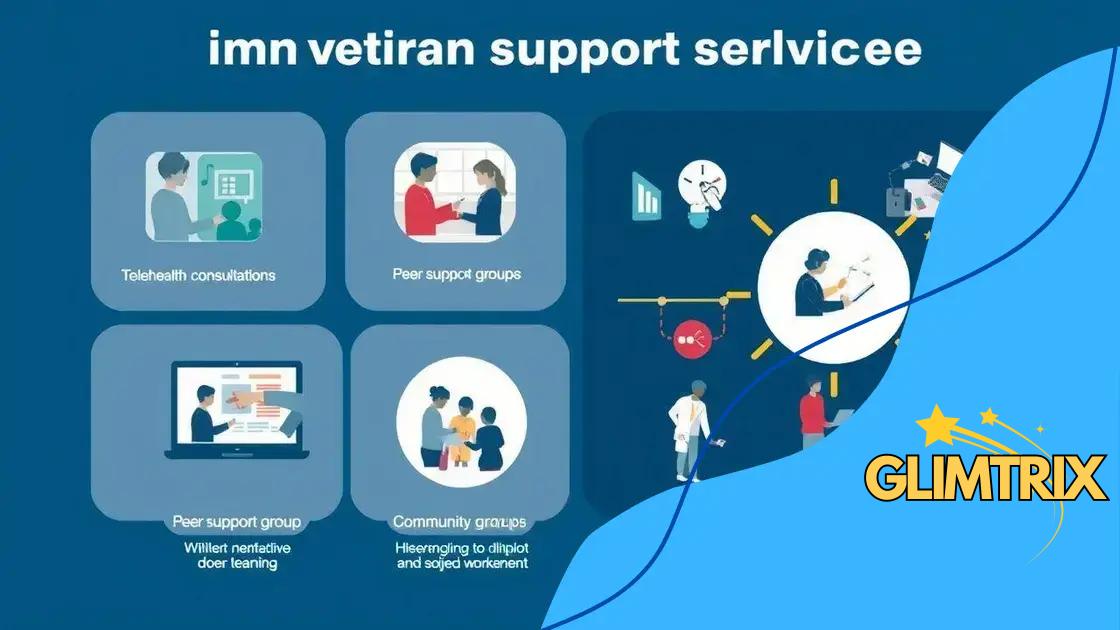Veteran support services modernization: improving lives today

Veteran support services modernization focuses on enhancing accessibility and effectiveness through technology, community engagement, and personalized care, ensuring veterans receive the comprehensive assistance they need to improve their quality of life.
Veteran support services modernization is crucial for enhancing the quality of life for those who served our country. Have you ever wondered how these changes can affect the lives of veterans in your community? Let’s delve into this vital topic.
Understanding veteran support services
Understanding veteran support services is essential in ensuring that those who have served our country receive the assistance they need. With various organizations dedicated to helping veterans, it’s important to know how these services operate and what they can offer.
Many veterans face unique challenges after returning home, which is why support services must adapt to their specific needs. These services range from healthcare to job placement and mental health support. In understanding these services, we can better appreciate their impact on veterans’ lives.
The Main Types of Veteran Support Services
There are several main types of support services available for veterans that address different aspects of their lives:
- Healthcare Services: Offering physical and mental health support tailored to veterans’ needs.
- Employment Assistance: Helping veterans transition to civilian jobs through training and job placement services.
- Education Benefits: Providing financial support for veterans pursuing further education or training.
- Housing Assistance: Offering programs to help veterans secure stable and affordable housing.
The accessibility of these services can make a significant difference for veterans. Understanding where to find help and how to navigate these systems empowers veterans to make informed decisions about their future. Organizations like the Department of Veterans Affairs (VA) play a crucial role by coordinating and offering many of these programs directly.
In addition to government services, many non-profits also contribute. They often focus on specific issues such as homelessness or mental health. Connecting veterans with these resources is a collaborative effort that benefits from community engagement and awareness.
When veterans are well-informed about the options available to them, they can better advocate for their needs. This understanding leads to more effective use of resources and improved outcomes for their overall well-being.
Current challenges in veteran assistance
Current challenges in veteran assistance have emerged as significant barriers that impede the well-being of many service members. Understanding these challenges is essential for improving the support systems available to veterans.
One major issue is the lack of awareness among veterans regarding the services available to them. Many veterans do not know where to turn for help, which can delay their access to necessary resources. Additionally, service providers often struggle to reach veterans in remote or underserved areas, creating disparities in access.
Barriers to Accessing Support Services
Several barriers hinder veterans from obtaining the assistance they need:
- Long wait times: Many veterans face lengthy waiting periods for appointments and services, which can discourage them from seeking help.
- Complexity of the system: The variety of programs and requirements can be overwhelming, making it difficult for veterans to navigate the benefits they deserve.
- Insufficient funding: Many organizations rely on limited resources, affecting their ability to provide comprehensive support.
- Stigma around seeking help: Some veterans may feel stigma associated with asking for assistance, particularly related to mental health.
These challenges contribute to a cycle of disconnection for many veterans. When faced with obstacles like these, the necessary support may feel out of reach. However, community involvement can play a vital role in bridging gaps.
Another significant challenge is the rising number of homeless veterans. The lack of affordable housing options exacerbates this problem. Many veterans struggle to reintegrate into civilian life, leading to potential housing instability. Increased collaboration between local organizations, government, and volunteers is needed to tackle this issue effectively.
Further complicating these challenges is the ongoing need for mental health support. Many veterans experience issues such as PTSD and depression but may not seek help due to various factors, including stigma and lack of awareness of resources. By creating open dialogues and supportive environments, communities can foster trust, encouraging veterans to seek the help they need.
Innovative solutions for modernization

Innovative solutions for modernization of veteran support services are essential for meeting the evolving needs of those who have served. These advancements enhance access and streamline the support process, ensuring veterans receive prompt and effective assistance.
Technology plays a pivotal role in this modernization. By leveraging tools like telehealth and mobile applications, veterans can connect with healthcare providers from the comfort of their homes. This accessibility can significantly improve mental health outcomes, especially for those in remote locations.
Key Innovative Approaches
Here are some key innovative solutions that are shaping veteran assistance:
- Data-Driven Decision Making: Utilizing big data to analyze the needs of veterans helps organizations tailor services and improve outreach.
- Peer Support Programs: Connecting veterans with peers who share similar experiences can foster understanding and provide relatable support.
- Integrated Care Models: Combining physical and mental health services ensures a holistic approach to veteran care.
- Online Resources: Creating user-friendly websites and mobile apps allows veterans to access information and support services easily.
These approaches can enhance not only the effectiveness of services but also the veterans’ overall experience. Tailoring support to individual needs demonstrates a commitment to meeting veterans where they are, both geographically and emotionally.
Furthermore, community engagement is crucial in implementing these innovations. Local organizations and volunteers can facilitate workshops and events to educate veterans about available resources. By fostering a collaborative environment, support organizations can help break down barriers and increase participation.
Another significant development is the emphasis on mental health awareness and support. Initiatives that focus on reducing the stigma surrounding mental health issues can encourage veterans to seek help when they need it. Encouraging open discussions and promoting resources play a key role in changing perceptions.
The role of technology in veteran support
The role of technology in veteran support has transformed how services are delivered, making assistance more accessible and efficient. Innovative tools are reshaping the landscape of support available to veterans, ensuring they receive timely care and resources.
One significant advancement is the use of telehealth. This allows veterans to connect with healthcare providers remotely, reducing barriers such as travel and wait times. With telehealth, veterans can easily access mental health services and medical consultations, enhancing their well-being.
Key Innovations in Veteran Support Technology
Here are some key innovations that illustrate the impact of technology:
- Mobile Applications: Apps designed for veterans provide on-the-go access to essential resources, including appointment scheduling and health tracking.
- Virtual Reality Therapy: Innovative treatments using virtual reality help veterans cope with PTSD by recreating controlled environments for exposure therapy.
- Online Community Platforms: These platforms foster connections between veterans, allowing them to share experiences and support one another.
- Data Analytics: Organizations can use data to identify trends and improve services, ensuring veterans receive personalized care.
These technologies not only improve access but also enhance engagement. Veterans are more likely to participate in programs that employ user-friendly digital tools. Moving support services online can empower veterans to take charge of their health and well-being.
Another area where technology plays a crucial role is in education and training. With online courses and resources, veterans can pursue new skills and certifications from the comfort of their homes. This flexibility makes it easier for them to transition into civilian careers.
As technology evolves, so do its applications in veteran support. Staying current with these advancements ensures that veterans can benefit from the latest resources available to them. Communities should advocate for these technologies to ensure they are fully utilized and accessible to all veterans.
Future outlook for veteran services
The future outlook for veteran services is focused on enhancing support and ensuring that veterans receive the care they deserve. As society evolves, so do the needs of veterans, making it essential for services to adapt accordingly.
One promising development is the ongoing integration of technology into veteran services. This includes advancements like Artificial Intelligence and data analytics, which can help identify the needs of veterans more effectively. By harnessing these tools, organizations can tailor their approaches and provide personalized care.
Emerging Trends in Veteran Services
Several emerging trends are shaping the future of veteran assistance:
- Collaborative Models: Partnerships between government agencies and non-profits are becoming more common, allowing for a comprehensive approach to support.
- Focus on Mental Health: Recognizing the importance of mental health, services are increasingly prioritizing these needs and integrating mental health resources into standard care.
- Community Engagement: Fostering local involvement and support helps create stronger networks for veterans, encouraging them to seek help when needed.
- Holistic Approaches: Services are beginning to embrace a more holistic view of health, addressing physical, emotional, and social well-being as interconnected components.
As these trends continue to develop, the emphasis on community and individualized care will likely lead to improved outcomes for veterans. With greater outreach and more accessible resources, veterans can find the support they need more easily.
Advocacy efforts are also expected to grow, ensuring that veteran issues remain a priority in policy discussions. By pushing for better funding and resources, advocates can help create a more favorable environment for expanding services.
Moreover, the impact of remote services is likely to remain significant. Telehealth and online support groups will continue to facilitate connections for veterans who may not otherwise seek assistance. This shift towards virtual options represents a critical step in making services more inclusive.
FAQ – Frequently Asked Questions About Veteran Support Services
How is technology improving veteran support services?
Technology is enhancing veteran support by offering telehealth options and mobile applications, making it easier for veterans to access healthcare and resources.
What are the benefits of community engagement in veteran services?
Community engagement fosters stronger networks for veterans, encouraging them to seek help and creating a supportive environment.
Why is mental health support critical for veterans?
Many veterans experience mental health challenges, and prioritizing mental health resources is essential for improving their overall well-being.
What partnerships are important for improving veteran services?
Collaborations between government agencies and non-profits help create comprehensive care models that better address veterans’ needs.





